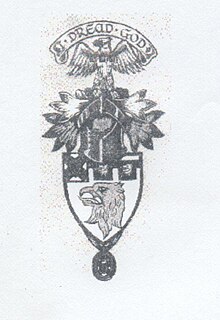Sir Benedict Munro, Baron von Meikeldorf was a Scottish soldier of the English and Scottish Civil War who settled in Germany during the mid 17th century. [1] He is believed to have been born between 1615 and 1630. [1]

Scotland is a country that is part of the United Kingdom. Sharing a border with England to the southeast, Scotland is otherwise surrounded by the Atlantic Ocean to the north and west, by the North Sea to the northeast and by the Irish Sea to the south. In addition to the mainland, situated on the northern third of the island of Great Britain, Scotland has over 790 islands, including the Northern Isles and the Hebrides.

Germany, officially the Federal Republic of Germany, is a country in Central and Western Europe, lying between the Baltic and North Seas to the north, and the Alps to the south. It borders Denmark to the north, Poland and the Czech Republic to the east, Austria and Switzerland to the south, France to the southwest, and Luxembourg, Belgium and the Netherlands to the west.
Benedict was the youngest son of Robert Munro, Commissary of Caithness, who in turn was the third son of John Mor Munro, 3rd of Coul, a descendant of George Munro, 10th Baron of Foulis. [2]
A commissary is a government official charged with oversight or an ecclesiastical official who exercises in special circumstances the jurisdiction of a bishop.

Caithness is a historic county, registration county and lieutenancy area of Scotland.
George Munro of Foulis is traditionally the 10th Baron and 13th successive chief of the Clan Munro. However he is only the third successive chief of the clan who can be proved by contemporary evidence. He was the eldest son of Hugh Munro, 9th Baron of Foulis and was seated at Foulis Castle.
Benedict was in the prime of his life when he fought in the royalist army at the Battle of Worcester in 1651 against the army of Oliver Cromwell. The royalists were defeated, however Benedict escaped to Germany. [1] He grew to become Baron Benedict von Meikeldorf, lord of a petty German dukedom, the like of which once divided the country. In 1900 his descendants still held a baronial state there. [1]

The Battle of Worcester took place on 3 September 1651 at Worcester, England, and was the final battle of the English Civil War. Oliver Cromwell's Parliamentarian New Model Army, 28,000 strong, defeated King Charles II's 16,000 Royalists, of whom the vast majority were Scottish.

Oliver Cromwell was an English military and political leader. He served as Lord Protector of the Commonwealth of England, Scotland, and Ireland from 1653 until his death, acting simultaneously as head of state and head of government of the new republic.
One of Benedict's older brothers William Munroe was captured at the Battle of Worcester and deported to America where he became a successful land owner. [1]
William Munroe was a 17th-century Scottish soldier who later became a settler in the United States and a Freemason.








